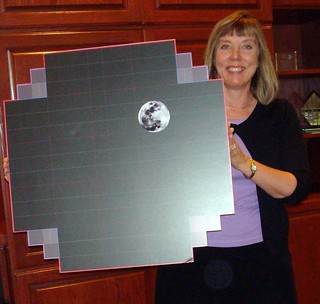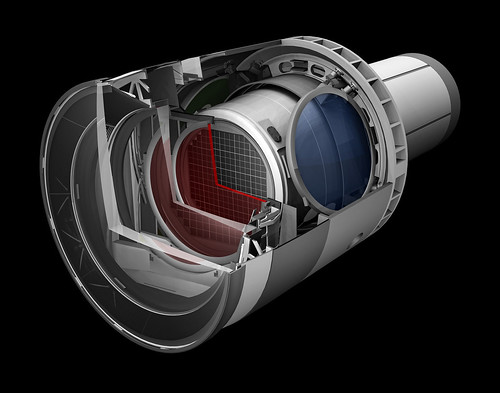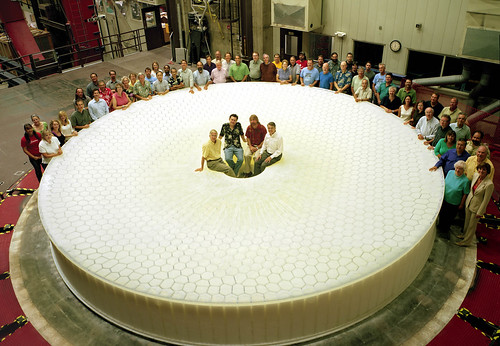Difference between revisions of "LSST Camera"
m (math, d'oh) |
(Add rendering of the camera (duh) and re-arranging) |
||
| Line 1: | Line 1: | ||
| + | {|class=floatright | ||
| + | | | ||
| + | {{Flickr_image | ||
| + | |image_source= https://www.flickr.com/photos/camerawiki/16225526649/in/pool-camerawiki | ||
| + | |image= http://farm8.staticflickr.com/7340/16225526649_dfda6aae03.jpg | ||
| + | |image_align= right | ||
| + | |image_text= The planned 3,200 megapixel LLST camera. Two large corrector lenses<br>and two of five spectral-bandpass filters are visible in this cutaway rendering. | ||
| + | |image_by= LSST Corporation | ||
| + | |image_rights= non-commercial | ||
| + | }} | ||
| + | |- | ||
| + | | | ||
{{Flickr_image | {{Flickr_image | ||
|image_source= https://www.flickr.com/photos/camerawiki/16397557482/in/pool-camerawiki | |image_source= https://www.flickr.com/photos/camerawiki/16397557482/in/pool-camerawiki | ||
| − | |image= http://farm9.staticflickr.com/8666/ | + | |image= http://farm9.staticflickr.com/8666/16397557482_7a0ce2e99a.jpg |
|image_align= right | |image_align= right | ||
| − | |image_text= The 8.4m-diameter glass blank for the LSST, shown here before shaping and silvering. | + | |image_text= The 8.4m-diameter glass blank for the LSST, shown here before<br>shaping and silvering. This element will serve both as primary and tertiary mirror.<br>The hollow honeycomb structure maintains stiffness while omitting unnecessary mass. |
|image_by= LSST Corporation | |image_by= LSST Corporation | ||
|image_rights= non-commercial | |image_rights= non-commercial | ||
}} | }} | ||
| + | |} | ||
The '''LSST Camera''' is the digital-imaging package planned for the [http://www.lsst.org/lsst/about Large Synoptic Survey Telescope] under construction at Cerro Pachon in Chile. | The '''LSST Camera''' is the digital-imaging package planned for the [http://www.lsst.org/lsst/about Large Synoptic Survey Telescope] under construction at Cerro Pachon in Chile. | ||
Revision as of 18:53, 31 January 2015
| ||
|
The LSST Camera is the digital-imaging package planned for the Large Synoptic Survey Telescope under construction at Cerro Pachon in Chile.
According to its design team, this will be the largest "digital camera" ever constructed—albeit one highly specialized for astrophotography. The design as planned "will be the size of a small car and weigh more than 3 tons[1]" (excluding the optics of the telescope), with a sensor array boasting 3,200 megapixels.
It is not possible to fabricate a monolithic silicon image sensor of the required size. Current plans call for an array of roughly 200 individual 42x42 mm square CCD chips, each encompassing 16 megapixels. These are to be butted edge to edge with a minimal loss of imaging area.
To maximize sensitivity to faint light, each CCD pixel is about 10x10 µm square (about 40% more area than the pixels of the Sony a7S, perhaps today's most low-light-capable consumer model). Furthermore the sensor will be cooled to -100°C within a vacuum chamber to minimize spurious thermal noise.
There is no color filter array over the sensor. Instead the camera has a system of five 75 cm-wide filters, each of which passes a different spectral band, which can be swapped into place over the entire sensor for sequential exposures.[2]
In January, 2015 the camera design team at SLAC received “Critical Decision 2” approval from the US Department of Energy, which continues funding to develop the instrument.[1]
Telescope optics
The LSST itself is an unusual telescope, optimized for rapid, repeated wide-field imaging of the entire sky in order to capture transient phenomena. It essentially represents a massive f/1.2 telephoto lens with an effective focal length of 10,310 mm.[3]
The telescope's design calls for a folded light path to allow for a shorter and more maneuverable telescope structure. The primary mirror is 8.4 meters in diameter (over 27 feet), however the central 5 meters are figured to a deeper curvature to serve as the system's tertiary mirror (M3), and do not contribute to its light-gathering area. (An unobstructed 6.7m telescope would have equivalent light-gathering power.[2])
In addition to the three-bounce mirror elements, the telescope also includes corrector lenses to provide a flat field at the sensor plane. The largest of these is 1.55 m or ~5 feet in diameter[2].

|
| A mockup showing the size of the planned 3,200-megapixel imaging array for the Large Synoptic Survey Telescope. The moon photograph pasted overtop illustrates the angular coverage of the telescope's field of view. image by LSST Corporation (Image rights) |
Notes
- ↑ 1.0 1.1 "World’s Most Powerful Camera Receives Funding Approval" from SLAC National Accelerator Laboratory of Stanford University
- ↑ 2.0 2.1 2.2 "Optical Design" from lsst.org
- ↑ " The effective focal length of the optical system is 10.31-m making the final f-number 1.2345," according to an LSST presentation poster.

